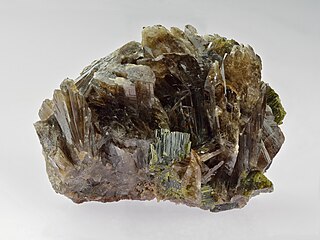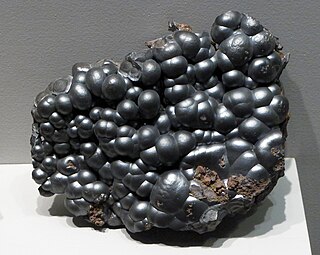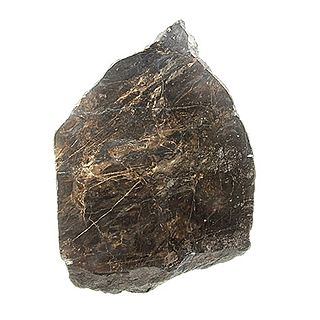Related Research Articles

Axinite is a brown to violet-brown, or reddish-brown bladed group of minerals composed of calcium aluminium boro-silicate, (Ca,Fe,Mn)3Al2BO3Si4O12OH. Axinite is pyroelectric and piezoelectric.

Hibonite is a mineral with the chemical formula (Ca,Ce)(Al,Ti,Mg)12O19, occurring in various colours, with a hardness of 7.5–8.0 and a hexagonal crystal structure. It is rare, but is found in high-grade metamorphic rocks on Madagascar. Some presolar grains in primitive meteorites consist of hibonite. Hibonite also is a common mineral in the Ca-Al-rich inclusions found in some chondritic meteorites. Hibonite is closely related to hibonite-Fe ) an alteration mineral from the Allende meteorite. Hibonites were among the first minerals to form as the disk of gas and dust swirling around the young sun cooled.

Periclase is a magnesium mineral that occurs naturally in contact metamorphic rocks and is a major component of most basic refractory bricks. It is a cubic form of magnesium oxide (MgO). In nature it usually forms a solid solution with wüstite (FeO) and is then referred to as ferropericlase or magnesiowüstite.

Ankerite is a calcium, iron, magnesium, manganese carbonate mineral of the group of rhombohedral carbonates with the chemical formula Ca(Fe,Mg,Mn)(CO3)2. In composition it is closely related to dolomite, but differs from this in having magnesium replaced by varying amounts of iron(II) and manganese. It forms a series with dolomite and kutnohorite.

Lithiophilite is a mineral containing the element lithium. It is lithium manganese(II) phosphate with chemical formula LiMnPO4. It occurs in pegmatites often associated with triphylite, the iron end member in a solid solution series. The mineral with intermediate composition is known as sicklerite and has the chemical formula Li(Mn,Fe)PO4). The name lithiophilite is derived from the Greek philos (φιλός) "friend", as lithiophilite is usually found with lithium.

Warwickite is an iron magnesium titanium borate mineral with the chemical formula (MgFe)3Ti(O, BO3)2orMg(Ti,Fe3+, Al)(BO3)O. It occurs as brown to black prismatic orthorhombic crystals which are vitreous and transparent. It has a Mohs hardness of 3 to 4 and a specific gravity of 3.36.

Romanèchite ((Ba,H2O)2(Mn4+,Mn3+)5O10) is the primary constituent of psilomelane, which is a mixture of minerals. Most psilomelane is not pure romanechite, so it is incorrect to consider them synonyms. Romanèchite is a valuable ore of manganese, which is used in steelmaking and sodium battery production. It has a monoclinic crystal structure, a hardness of 6 and a specific gravity of 4.7–5. Romanèchite's structure consists of 2 × 3 tunnels formed by MnO6 octahedra.

Akaganeite, also written as the deprecated Akaganéite, is a chloride-containing iron(III) oxide-hydroxide mineral, formed by the weathering of pyrrhotite (Fe1−xS).

Galaxite, also known as 'mangan-spinel' is an isometric mineral belonging to the spinel group of oxides with the ideal chemical formula Mn2+Al2O4.

Chloritoid is a silicate mineral of metamorphic origin. It is an iron magnesium manganese alumino-silicate hydroxide with formula (Fe, Mg, Mn)
2Al
4Si
2O
10(OH)
4. It occurs as greenish grey to black platy micaceous crystals and foliated masses. Its Mohs hardness is 6.5, unusually high for a platy mineral, and it has a specific gravity of 3.52 to 3.57. It typically occurs in phyllites, schists and marbles.

Jacobsite is a manganese iron oxide mineral. It is in the spinel group and forms a solid solution series with magnetite. The chemical formula is (Mn,Mg)Fe2O4 or with oxidation states and substitutions: (Mn2+,Fe2+,Mg)(Fe3+,Mn3+)2O4.

Cafetite is a rare titanium oxide mineral with formula (Ca,Mg)(Fe,Al)
2Ti
4O
12·4(H
2O). It is named for its composition, Ca-Fe-Ti.

Cabalzarite is a rare arsenate mineral with the chemical formula Ca(Mg,Al,Fe3+
)
2[AsO
4]
2•2(H
2O,OH). It is a member of the tsumcorite group. It crystallizes in the monoclinic system and typically occurs as clusters of crystals or granular aggregates.

Gedrite is a crystal belonging to the orthorhombic ferromagnesian subgroup of the amphibole supergroup of the double chain inosilicate minerals with the ideal chemical formula Mg2(Mg3Al2)(Si6Al2)O22(OH)2.
Almarudite is an extremely rare alkaline manganese beryllium silicate mineral of the cyclosilicates class, with the chemical formula K([ ],Na)2(Mn2+,Fe2+,Mg)2(Be,Al)3[Si12O30], from the volcanic environment of the Eifel Mountains in Germany.

Hureaulite is a manganese phosphate with the formula Mn2+5(PO3OH)2(PO4)2·4H2O. It was discovered in 1825 and named in 1826 for the type locality, Les Hureaux, Saint-Sylvestre, Haute-Vienne, Limousin, France. It is sometimes written as huréaulite, but the IMA does not recommend this for English language text.

Zemannite is a very rare oxide mineral with the chemical formula Mg0.5ZnFe3+[TeO3]3·4.5H2O. It crystallizes in the hexagonal crystal system and forms small prismatic brown crystals. Because of the rarity and small crystal size, zemannite has no applications and serves as a collector's item.

Ludlamite is a rare phosphate mineral with chemical formula (Fe,Mn,Mg)3(PO4)2·4H2O. It was first described in 1877 for an occurrence in Wheal Jane mine in Cornwall, England and named for English mineralogist Henry Ludlam (1824–1880).

Jimthompsonite is a magnesium iron silicate mineral with chemical formula (Mg,Fe2+)5Si6O16(OH)2. It is a triple chain silicate (or inosilicate) along with clinojimthompsonite and chesterite. They were described in 1977 by Burham and Veblen. They attracted great mineralogical attention because they were the first examples of new chain silicate structures among a large group known as biopyriboles whose name is derived from the words biotite, pyroxene, and amphiboles.
Chvaleticeite is a monoclinic hexahydrite manganese magnesium sulfate mineral with formula: (Mn2+, Mg)[SO4]·6(H2O). It occurs in the oxidized zone of manganese silicate deposits with pyrite and rhodochrosite that have undergone regional and contact metamorphism. It is defined as the manganese dominant member of the hexahydrite group.
References
- ↑ Warr, L.N. (2021). "IMA-CNMNC approved mineral symbols". Mineralogical Magazine. 85 (3): 291–320. Bibcode:2021MinM...85..291W. doi: 10.1180/mgm.2021.43 . S2CID 235729616.
- ↑ Hey, M. H. (December 1964). "Twenty-third list of new mineral names". Mineralogical Magazine and Journal of the Mineralogical Society. 33 (267): 1125–1160. Bibcode:1964MinM...33.1125H. doi:10.1180/minmag.1964.033.267.08. ISSN 0369-0148.
- ↑ Kozlov I.T. and Levshov P.P. (1962). "Amakinite". euromin.w3sites.net. Retrieved 26 December 2022.